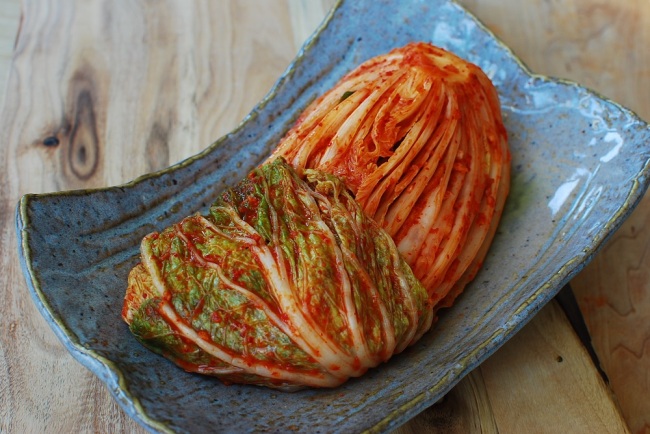 |
Pogi kimchi (Napa cabbage kimchi). (Korean Bapsang) |

It’s kimchi-making season! There are hundreds of kimchi varieties in Korea. Pogi kimchi is the most common variety. The taste of kimchi varies widely, depending on the seasoning ingredients. Every household has its own version. Various kinds of jeotgal (salted seafood) are used to give kimchi its distinct pungency and to aid the fermentation process. Saeujeot (salted shrimp) and myeolchiaekjeot (fish sauce made with anchovies) are the two that are most commonly used. I almost always use both of these in my kimchi, as well as some fresh shrimp, which is my mother’s secret ingredient for adding extra freshness to the kimchi flavor. To help you start making kimchi at home, I came up with a recipe using one napa cabbage. Through this recipe, I hope you’ll find that it’s really not that difficult to make good kimchi at home.
Ingredients:
● 1 napa cabbage (about 2.5 kilograms)
● 1 cup coarse sea salt
● 5 cups of water
Seasoning:
● 1 tablespoon glutinous rice powder*
(*Mix it with 1/2 cup water, simmer over low heat until it thickens to a thin paste and cool. Yields about 3-4 tablespoons.)
● 1/2 cup Korean red chili pepper flakes, gochugaru (adjust to your taste)
● 1/4 cup saeujeot (salted shrimp), finely minced
● 3-4 raw shrimp (about 60 grams), finely minced
● 3 tablespoons myulchiaekjeot (fish sauce)
● 3 tablespoons minced garlic
● 1 teaspoon grated ginger
● 1 teaspoon sesame seeds
● 1/2 cup water
● 1 pound mu (Korean radish)
● 1/4 large Korean pear
● 3-4 scallions
● 2 large bowls
● a large colander
● kitchen gloves
● airtight container(s)
Cut the cabbage lengthwise into quarters. (This step is usually done by cutting the stem end in half only about 8―10 centimeters in. Then, slowly pull apart to separate into two pieces by hand. Do the same for each half to make quarters. Running the knife through all the way would unnecessarily cut off the cabbage leaves.)
In a large bowl, dissolve 1/2 cup of salt in 5 cups of water. Thoroughly bathe each cabbage quarter in the salt water one at a time, shake off excess water back into the bowl, and then transfer to another bowl.
Using the other half cup of salt and starting from the outermost leaf, generously sprinkle salt over the thick white part of each leaf (similar to salting a piece of meat). Try to salt all the cabbage quarters with 1/2 cup salt, but you can use a little more if needed. Repeat with the rest of the cabbage quarters. Pour the remaining salt water from the first bowl over the cabbage. Set aside for about 6-8 hours, rotating the bottom ones to the top every 2-3 hours.
The cabbages are ready to be washed when the white parts are easily bendable. Rinse thoroughly 3 times, especially between the white parts of the leaves. Drain well, cut side down.
Meanwhile, make the glutinous rice paste and cool. Prepare the other seasoning ingredients. Mix all the seasoning ingredients well, including the rice paste and water. Set aside while preparing the other ingredients in order for the red pepper flakes to dissolve slightly and become like a paste.
Cut the radish and pear into match sticks (use a mandoline if available). Roughly chop the scallions. Transfer to a large bowl and combine with the seasoning mix. Mix well by hand. Taste a little bit. It should be a little too salty to eat as is. Add salt, more salted shrimp or fish sauce, if necessary. Let it sit for 30 minutes to an hour to allow the flavors to meld nicely.
Cut off the tough stem part from each cabbage quarter, leaving enough to hold the leaves together. Place one cabbage quarter in the bowl with the radish mix. Spread the radish mix over each leaf, one to two tablespoons for large leaves. (Eyeball the stuffing into 4 parts and use one part for each cabbage quarter.)
Fold the leaf part of the cabbage over toward the stem and nicely wrap with the outermost leaf before placing it, cut side up, in a jar or airtight container. Repeat with the remaining cabbages.
Once all the cabbages are in the jar or airtight container, rinse the bowl that contained the radish mix with 1/2 cup of water and pour over the kimchi. Press down hard to remove air pockets.
Leave it out at room temperature for a full day or two, depending on how fast you want your kimchi to ripen. Then, store in the fridge. Although you can start eating it any time, kimchi needs about two weeks in the fridge to fully develop the flavors. It maintains great flavor and texture for several weeks.
See more recipes at www.koreanbapsang.com.
By Ro Hyo-sun







![[Herald Interview] 'Trump will use tariffs as first line of defense for American manufacturing'](http://res.heraldm.com/phpwas/restmb_idxmake.php?idx=644&simg=/content/image/2024/11/26/20241126050017_0.jpg)
![[Health and care] Getting cancer young: Why cancer isn’t just an older person’s battle](http://res.heraldm.com/phpwas/restmb_idxmake.php?idx=644&simg=/content/image/2024/11/26/20241126050043_0.jpg)
